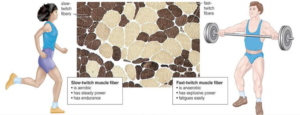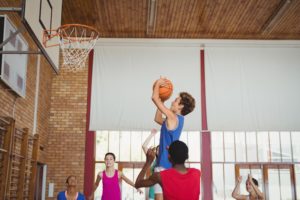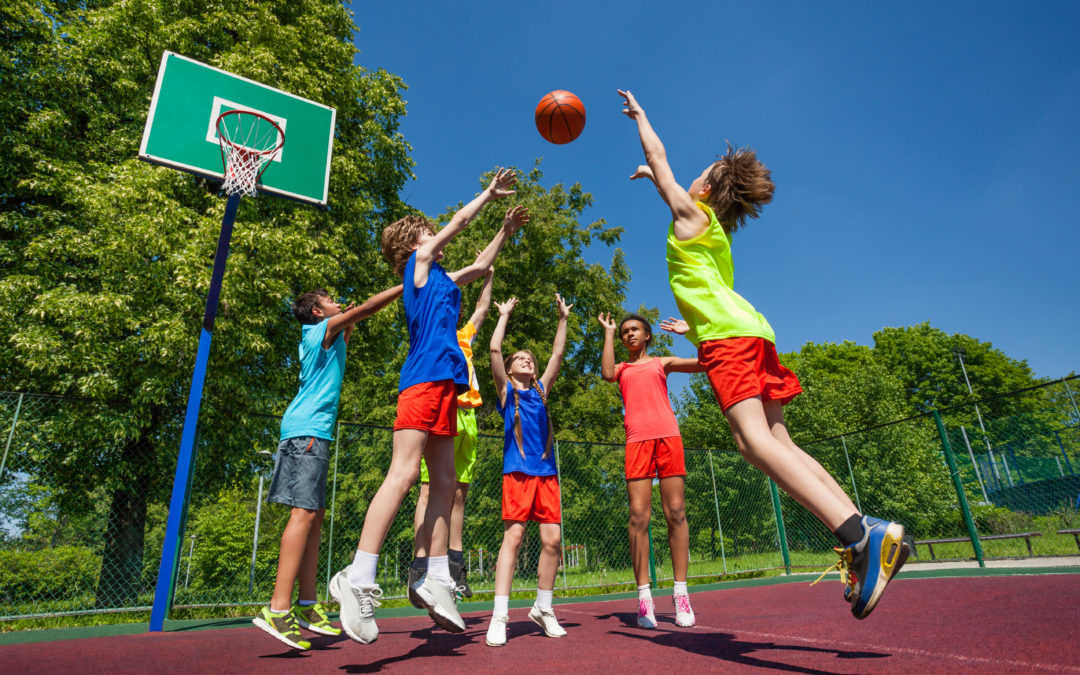Gravity does it’s best to hold athletes down to the ground. The ability to jump well is a serious advantage in most sports.
Not only does this skill move athletes closer to the clouds to hit, catch, or shoot, it helps with other skills like first step quickness and acceleration. While there are a variety of genetic factors that impact whether or not a young athlete can jump the highest, improving the mechanics of this skill can help all young athletes jump higher.
The good news is that no gimmicks, gadgets, or gurus are necessary in this process. All you need is a coach who understands the developmental process and the simple “starter kit” provided in this article.
First, let’s look at two of the common terms associated with training vertical jump.

“Fast Twitch Muscle Fibers”
In order for bodies to move, muscle fibers have to contract and relax. Over the years, science has discovered that not all muscle fibers are created equal when it comes to how fast and forceful they are able to contract. Researchers have discovered two primary types of muscle fiber, Type 1 “Slow Twitch” and Type 2 “Fast Twitch”.
Slow twitch muscle fibers are not great at producing a large amount of force because they rely on the relatively long process of oxidizing fat for energy. However, they are resilient to fatigue and can help athletes sustain low and moderate intensity endurance activities.
Fast twitch fibers can contract and produce a lot of force very quickly because they are able to use “hot” burning fuel stored right in the muscle. Unfortunately, these fibers also fatigue quickly.
 When considering the rate and amount of force required for the vertical jump, one can see that having more fast twitch muscle fibers can help you jump higher. So, can we train kids to have more of these?
When considering the rate and amount of force required for the vertical jump, one can see that having more fast twitch muscle fibers can help you jump higher. So, can we train kids to have more of these?
The answer is “not really”.
The first truth of athletic performance is that some kids receive greater genetic gifts from their parents. They literally are born with an advantage. This is true for muscle fiber type. Kids born with more fast twitch muscle fibers will nearly always have an advantage when it comes to vertical jump and other high force activities.
While some kids will have more fast twitch muscle fibers than others, all kids have a greater proportion of slow twitch muscle prior to puberty. As they enter and progress through puberty both genetics and training can slightly modify their proportion of fast twitch and slow twitch muscle.
However, prior to puberty, research has found that kids don’t convert muscle fiber types through training. Improvements in high force activities like jumping come from practicing the proper mechanics and coordination of jumping and doing it frequently.
No gadget, gimmick, or guru can sidestep this fact; For young athletes, practice makes perfect.
Plyometrics
 Vertical jumps and other explosive movements require athletes to quickly move their center of mass down in order to store elastic energy in the muscle, then quickly release that elastic energy as they move up. In the 60’s and 70’s the Soviets realized that training this elastic relationship helped athletes become more explosive.
Vertical jumps and other explosive movements require athletes to quickly move their center of mass down in order to store elastic energy in the muscle, then quickly release that elastic energy as they move up. In the 60’s and 70’s the Soviets realized that training this elastic relationship helped athletes become more explosive.
Americans coined the term “plyometrics” for this type of training. Simply put, plyometrics for the lower body is training the elastic relationship in the muscle through different speeds, depths, and heights of jumping activities.
Plyometric training is a valuable tool in helping kids improve vertical jump. Before the local guru swoops in to create a secretive “mystique” around their plyometrics training, realize that simple activities like jump rope, jumping jacks, and jumping over cones are extremely effective for kids.
It can’t be emphasized enough that prior to puberty, kids improve high force activities by learning to do them correctly and practicing them frequently. Training shouldn’t be a novelty circus. In order to do things correctly, young athletes have to master the basics. Excessive fatigue and over-complexity interrupt this process.
Plyometrics training creates a lot of fatigue, so few games and activities to allow kids to play with the jump movement and a few drills to practice technique are adequate for improving vertical jump in young children. Regardless of the needs of the sport, young athletes need to spend time and energy developing coordination, balance, strength and other athletic components as well.
Now that you can’t be fooled by slick marketing terms and outrageous claims, let’s look at a step-by-step starter kit to helping grade school age athletes improve vertical jump.
Please note that we provide rough ages for the introduction of skills. These are based on general milestones for attention and coordination. It’s important to note that while age provides a basic guideline, their actual skill level and willingness/ability to take coaching is the ultimate limiting factor.

Step 1: Play with Jumping (Introduce at age 3-5)
Before digging in to the nitty gritty of form and technique, it’s important that kids get to participate in games, activities, and drills that highlight jumping. This gives them an opportunity to learn and practice the basic elastic, power, and balance requirements.
The first “technique” aspect of coordination to address is helping kids leave the ground and land using both feet simultaneously. Create activities for both vertical and horizontal jumping and provide plenty of opportunities for repetition. Activities like the one below are a great way to start.
Lilly Pad Jump
Step 2: Elasticity (Introduce at age 3-5 for most kids)
As observed in research on plyometric training, vertical jump requires athletes to effectively store elastic energy in the “down” part of the vertical jump and release it during the “up” part. This “store and release” has to be done quickly and at a high magnitude in order to jump effectively.
From a technique standpoint, coaches should be looking to see if kids are able to “bounce” off the ground as opposed to “stomping” into the ground. This is where the notion of “balls of the feet” is effectively introduced.
Activities like those below are great ways to introduce and help young muscles practice this elastic process.
Popcorn Jumps
While steps 1 and 2 above are a suggested sequence to introduce jumping mechanics to your youngest athletes, they should remain part of the program as they progress as well.
Step 3: The Squat (Introduce specific technique at age 6-8 for most kids)
While kids of all ages should be practicing moving their hips towards the ground to squat, most kids will be receptive to coaching cues between the ages of 6 and 8. Learning how to squat correctly helps kids develop the coordination, strength, and stability of the jumping motion at a much more controlled speed.
Progressing to more complex jumping drills when children are unable to squat correctly is a recipe for creating an eventual performance ceiling or worse, injury.
Activities like the one below are great ways to introduce and develop the squat.
Static Wall Squat
Step 4: Jump and land (Introduce after the squat)
Now that young athletes have the basic framework of the vertical jump, it’s time to integrate an arm swing with the squat motion not only to create force to leave the ground, but to land in a controlled manner too.
Learning to land properly is important for a lot of reasons.
1. It helps develop the ability to store the elastic energy created during the “down” motion.
2. It develops deceleration and body control, which are important not only for improved performance, but injury prevention as well.
3. It creates a strong foundation for further movement after landing (run, shuffle, another jump) when in a sport.
Activities like the one below are great ways to introduce and practice the jumping sequence of arm swing, jumping, and landing.
1-2-3 Jumps
Remember, improvements in performance before puberty come from lots of proper practice. Once your athletes get comfortable with the steps introduced above, challenge them with activities that require them to:
1. Jump onto objects:
2. Jump over objects: (Jump Over and Land)
3. Jump in different directions: (1-2-3 Right-Left)
4. Jump at different heights and distances sequentially: (Uneven Cone Jumps)
5. Repeat the steps outlined above on 1 leg (hopping)
Regardless of how important vertical jump is for a particular sport, incorporate running mechanics, strength activities, and other aspects of general physical development into training. Remember, over-specialization provides no advantage to young athletes.
Coaches that take the time to build skills like the vertical jump and provide kids a fun, engaging training environment to practice them give kids a head start on being active and athletic for life.
Brett Klika CEO and co-founder of SPIDERfit is an international award- winning certified strength and conditioning coach, author, and motivational speaker with over 20 years experience motivating and inspiring youngsters to a life of health, fitness, and performance.
Brett consults with schools, athletic organizations, fitness professionals, and fortune 500 companies around the world.






Connect with SPIDERfit!